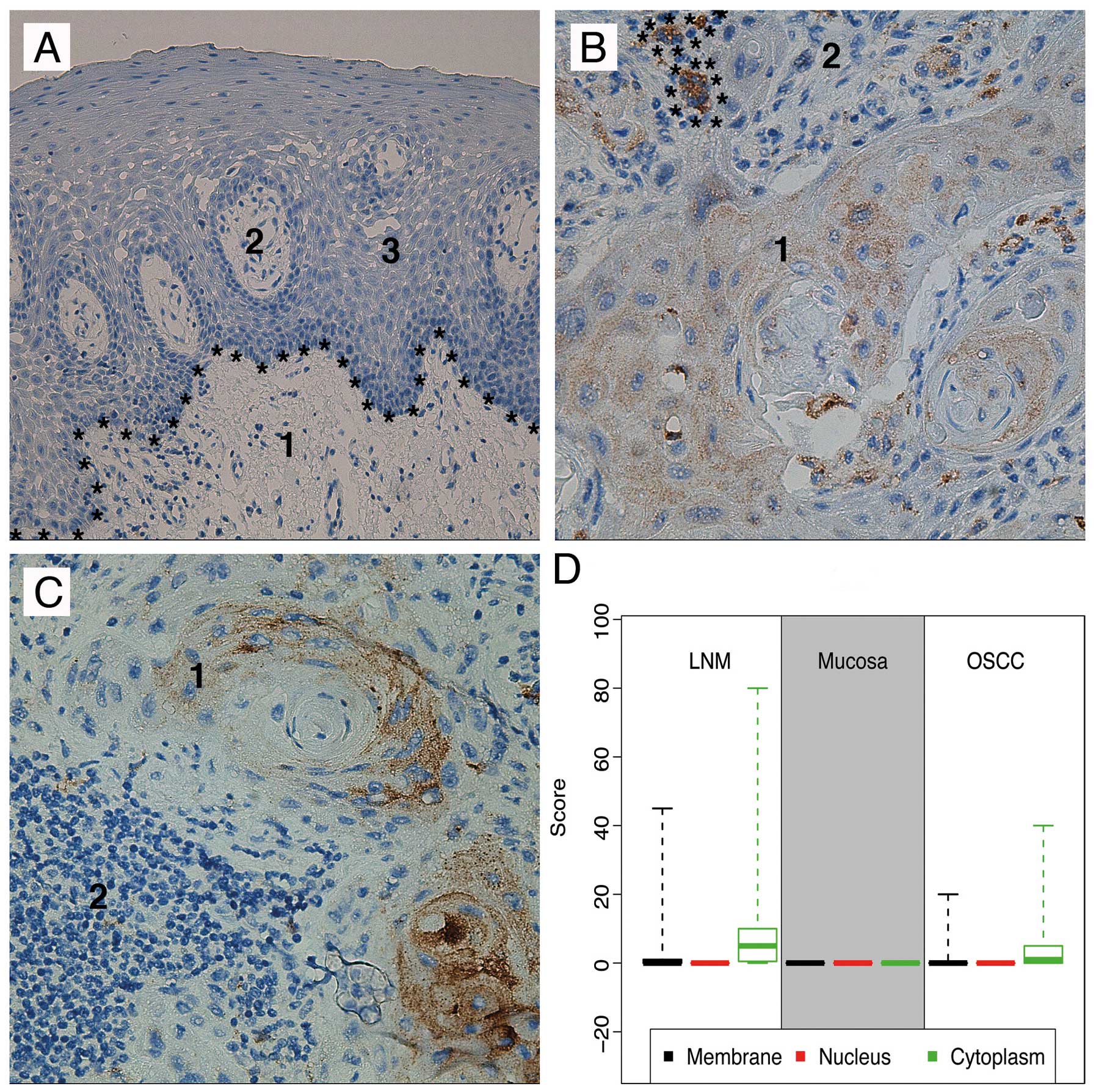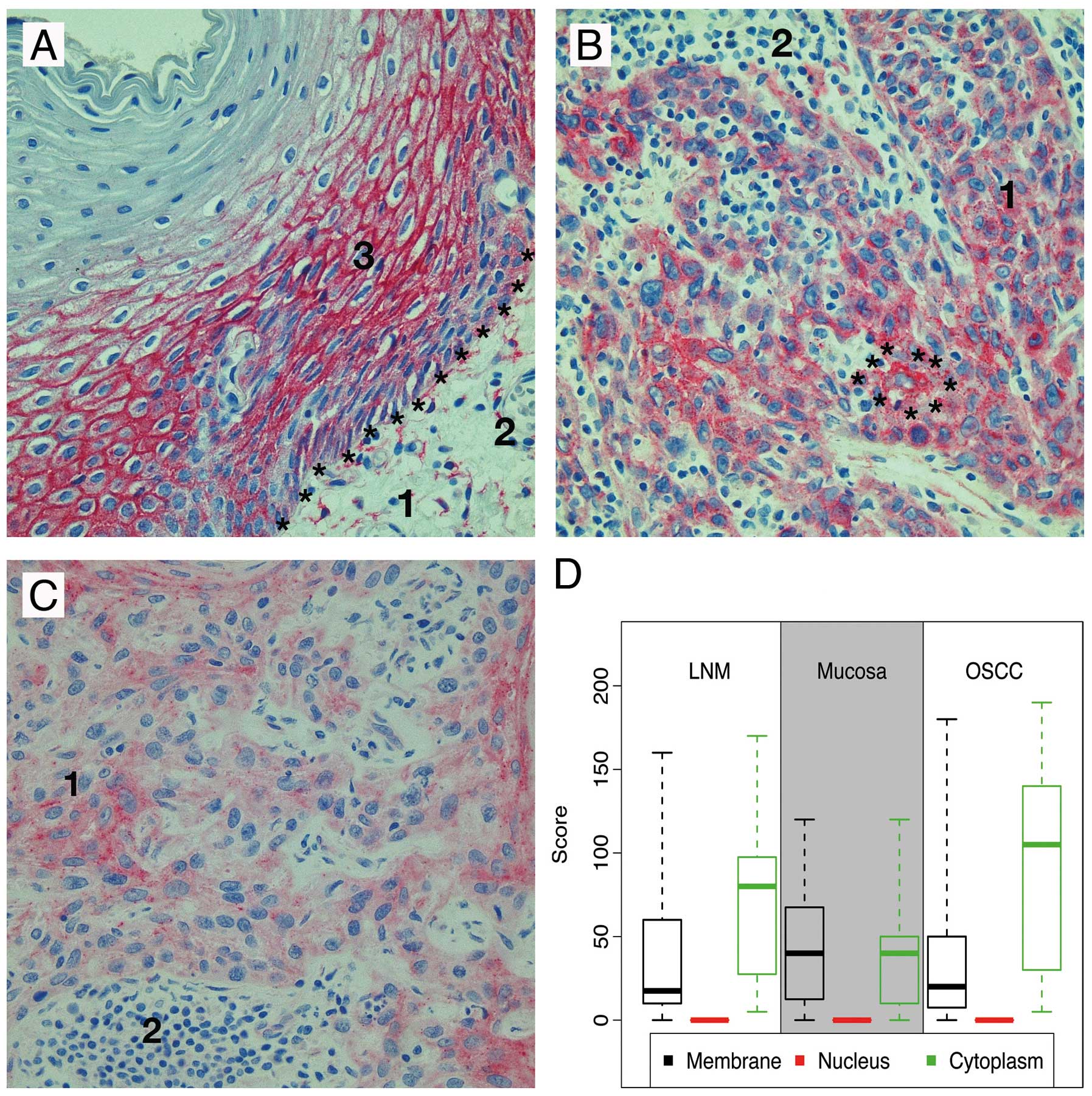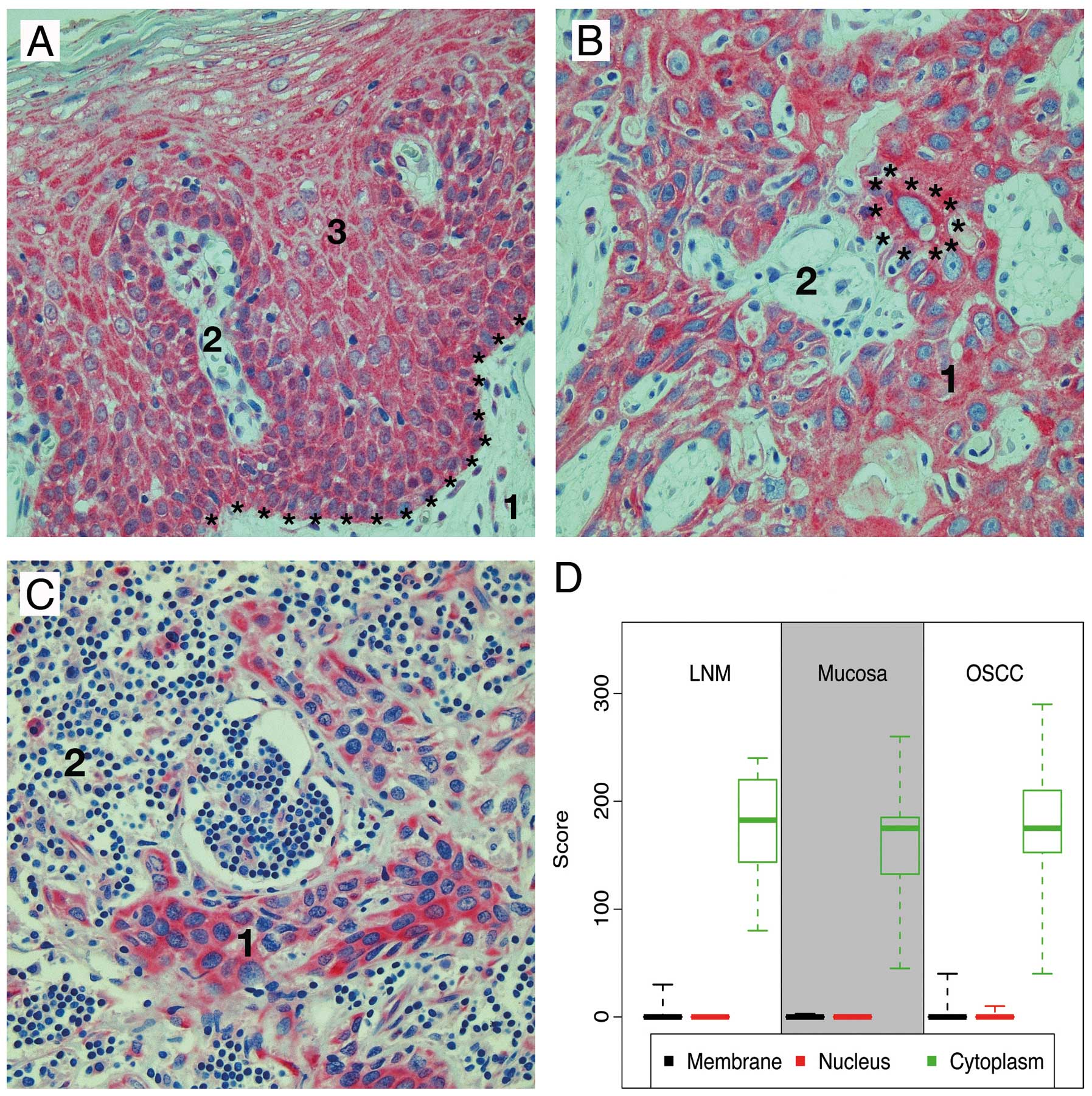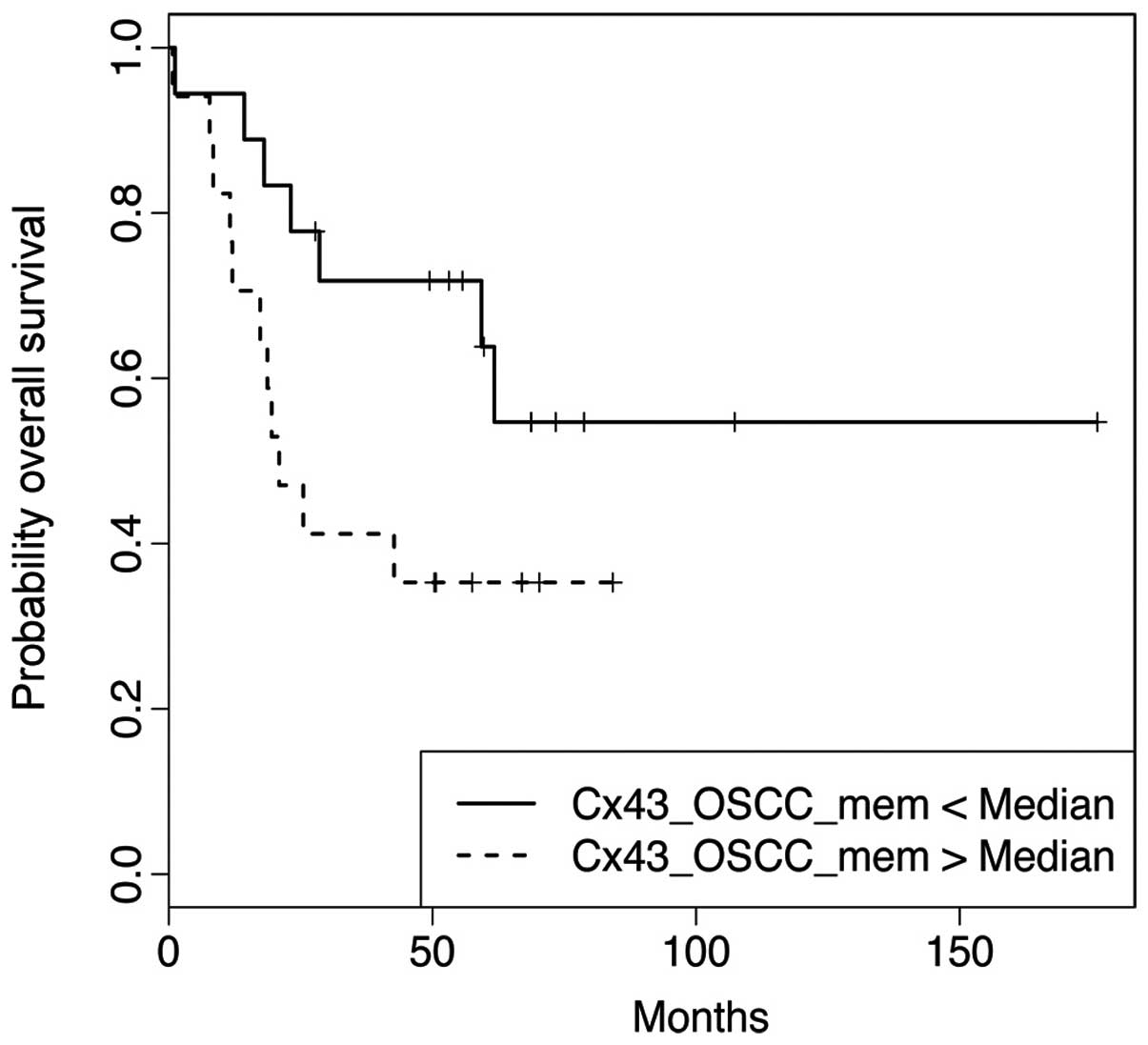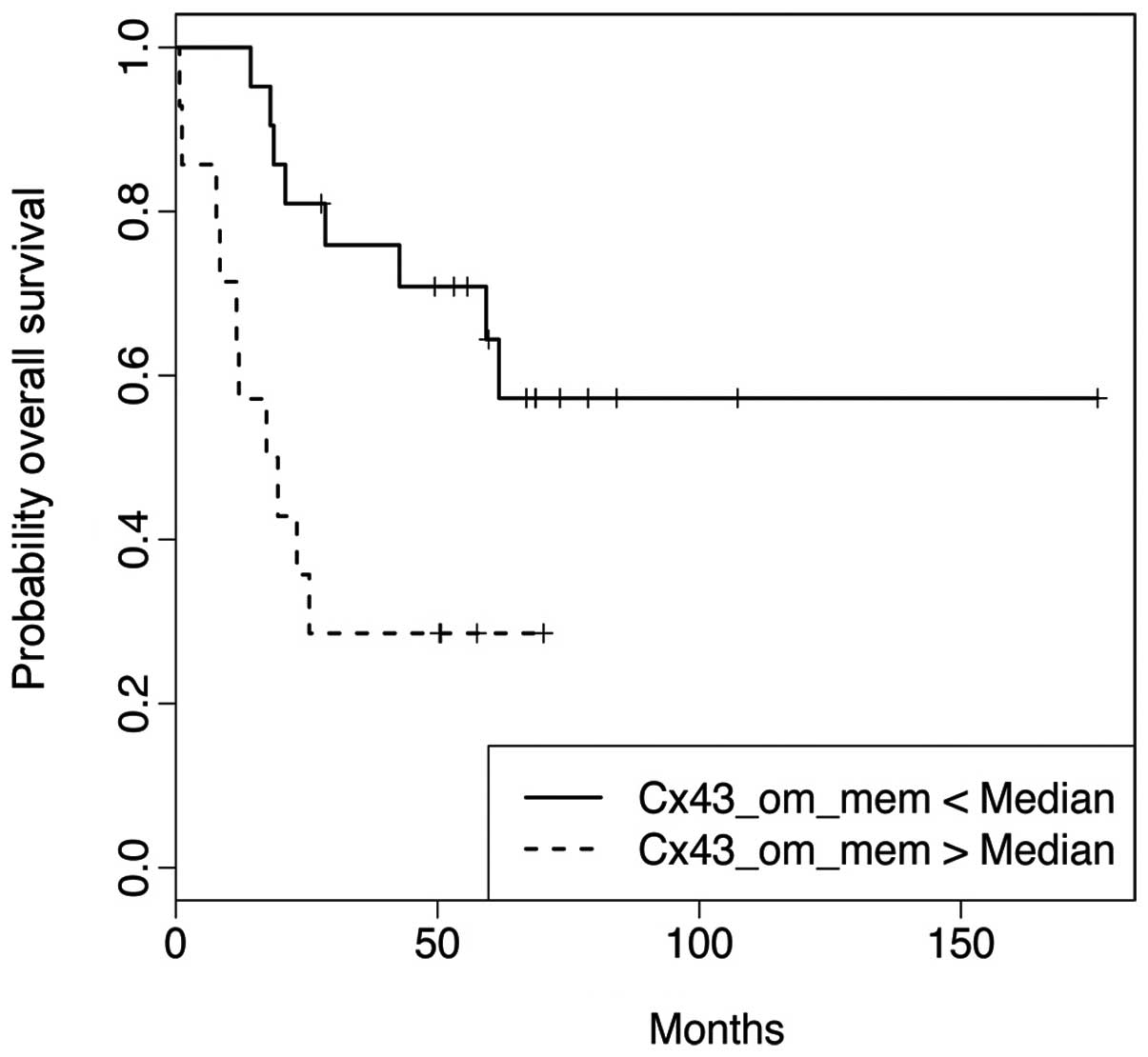Membrane connexin 43 acts as an independent prognostic marker in oral squamous cell carcinoma
- Authors:
- Published online on: April 23, 2014 https://doi.org/10.3892/ijo.2014.2394
- Pages: 273-281
Abstract
Introduction
Each year approximately 650,000 new cases of head and neck carcinomas are registered and approximately 350,000 deaths are documented. These tumours of the sinuses, oral cavity, the pharynx and larynx (1) are almost exclusively squamous cell carcinomas (SCC). Alcohol and tobacco abuse are the most important risk factors (2). The 5-year survival rate, considering all tumour stages, is approximately 60%. Due to a high incidence of metastases hypopharyngeal carcinomas have a significantly poorer prognosis (3). To better predict the prognosis of cancer patients and thereby adjust the therapeutic concept, several molecular prognostic factors are discussed in the literature (4). Connexins are components of gap junction (GJ) hemi channels (connexons), which are formed by homomeric or heteromeric connexin hexamers in the plasma membrane. Two connexons of adjacent cells can form a GJ-channel and allow gap junctional intercellular communication (GJIC) by promoting the passage of small molecules like ions or second messengers (5). GJIC plays a central role in maintaining tissue homoeostasis, cell growth control and development (5). The association between GJIC and an increased contact inhibition was first described in cultured hepatoma cells (6). GJIC has a different function depending on the stage of tumour progression. Connexins possibly act on cell growth by controlling the expression of cell cycle regulatory genes such as cyclin A, D1, D2, and cyclin-dependent kinases (CDKs) through a variety of mechanisms (7). Cx43 transfected cells suppress degradation of p27, which inhibits the enzymatic activity of CDK. The hypophosphorylated retinoblastoma gene product (Rb) thereby accumulates in the cell, which characterizes the G1 phase (7). The absence of GJIC can lead to an accumulation of growth factors in the cell (6) and the suppression of contact inhibition, resulting in cell proliferation (8). King et al described a correlation between the endogenous Cx43 expression and an increased growth control, showing that the growth capacity was decreased in HeLa cells of cervical cancer (9). Cx43 knockout in mice leads to astrocytes with altered expression of genes associated with apoptosis, cell growth and transcription factors (10,11) and an increased susceptibility of mice to pulmonary neoplasia (12). Similar results have been published for Cx26 and Cx43 expression in mammary MDA-MB-231 cells (13). Cx26 is responsible for contact growth inhibition in HeLa and HepG2 cells (14,15). Because Cx45 can form altered heteromeric gap junctions in cooperation with Cx43, Cx45 overexpression may affect intercellular contacts during carcinogenesis (16–18). Some connexin subtypes are also able to increase the attachment of tumour cells to the stroma during invasion and migration (7). Therefore, they can likely promote invasion by increasing communication with the endothelial barrier (19). Cx26 was detected in melanoma cells, surrounding small vessel endothelia (20), in squamous cell lung carcinoma (SCLC) and its associated lymph node metastases (21). Cx26 and Cx43 negative primary breast cancers developed Cx26 and Cx43 positive lymph node metastases (22). Cx43 enabled glioma cells to interact and establish functional GJ with astrocytes in the adult brain and facilitated direct parenchymal invasion (23). Data on connexin expression in OSCC are rare and conflicting observations were reported by Ozawa et al and Villaret et al, who described Cx26 overexpression in tissue samples of OSCC and lymph node metastases (24,25).
In the present study we analysed in detail the expression and subcellular localization of Cx26, Cx43 and Cx45 in tumour epithelia of OSCC, matching oral mucosa free of dysplasia, and lymph node metastases using a subtle immunoreactive score. We found that the expression of Cx26 and Cx45 had no prognostic value. Cx43 was upregulated in tumour epithelia and membrane Cx43 expression was associated with short OS.
Materials and methods
Patients
Tissue samples of 35 patients were screened and connexin expression levels were evaluated using immunohistochemistry. All patients suffered from a primary OSCC and were scheduled for surgical therapy in the Department of Oral and Maxillofacial Surgery of the University Medical Centre Goettingen without previous radiation or chemotherapy. The initial histopathological diagnosis was made by a separate biopsy before tumour ablation. The extent of resection and lymph node metastases were diagnosed histologically. Metastases of lung, liver and bone marrow were evaluated for all patients by chest radiography, abdominal ultrasound examination and 99mTc-MDP-scintigraphy (Table I). Patients gave written informed consent before they were included in this study. The study was conducted according to the ethical standards approved by the local ethics committee of the University of Goettingen (vote number 07/06/09).
Tissue samples
Tissue samples of primary OSCC, matching oral mucosa free of dysplasia, and associated lymph node metastasis were obtained immediately after tumour resection, fixed in neutrally buffered 4% formalin and embedded in paraffin. Immunohistochemical reactions were performed on 2-μm tissue sections. The staining procedures are summarized in Table II. Sections were counterstained with Meyer’s haematoxylin. Two independent investigators evaluated all tissue sections by light microscopy (Olympus, Tokyo), considering nuclear, membrane and cytoplasmic connexin staining by using an immunoreactive staining score (IRS). The intensity of staining was evaluated on a graded scale (0, negative; 1, weak; 2, intermediate; 3, strong). A total of 100% of positively stained cells was distributed on every density. For the final IRS, the scores of intensity and staining were multiplied and the mean value was calculated by forming the sum of the individual products. Total values ranged between 0 and 300. The application of the score is demonstrated in Table III.
Statistical analysis
The influence of general clinical parameters, such as gender, age at first diagnosis, nicotine and alcohol abuse, limiting systemic diseases, AJCC criteria and -stages, radio- and chemotherapy, localization of the primary tumour, extent of neck dissection and type of reconstruction, on the overall survival time was analysed using Cox proportional hazard regressions. The strength of the influence was described by the hazard ratio (with an additional 95% confidence interval). Connexin expression was correlated with survival time using the Kruskal-Wallis test and the associated baseline characteristics described above. The influence of the type of tissue (oral mucosa, primary cancer, lymph node metastasis and the subcellular localization (nucleus, cytoplasm, plasma membrane) and their interaction with the expression of each protein was analysed by non-parametric analysis of variance for data with repeated measurements (26). If significant interactions were observed, all tissue types and subcellular localization were also compared pairwise with each other using non-parametric analysis of variance. All tests were performed at a significance level of α=5% using the statistical software R (version 2.15, www.r-project.org).
Results
Connexin 26
No Cx26 expression was detected in dysplasia-free oral mucosa in any of the cellular compartments (Fig. 1A). Cx26 expression was significantly detected in the cytoplasm and membrane of primary OSCC (P<0.01). However, no nuclear expression was observed in primary OSCC tissue (Fig. 1B). Nevertheless, the signal strength was often at the lower limit of detection. Compared to primary OSCC, cytoplasmic (P<0.01) and membrane (P<0.01) Cx26 expression was significantly increased in lymph node metastases (Fig. 1C). No nuclear expression was detected in local metastases. The morphological distributions of Cx26 in the analysed tissues are shown in Fig. 1D. The data from the pairwise comparisons are summarized in Tables IV and V.
Table IV.Pairwise comparisons of connexin expression between the different localizations, separated by tissue type. |
Table V.Pairwise comparisons of connexin expression between the different tissue types, separated by localizations. |
Connexin 43
In dysplasia-free oral mucosa the strongest Cx43-signals were detected within the plasma membrane and at a lower level nearly exclusively in the lower half of the stratum spinosum (Fig. 2A). Compared to the matching oral mucosa tumour cells showed an upregulation of cytoplasmic Cx43 expression within tumour cells of the primary tumour and to a lower extent in lymph node metastases (P<0.01), whereas membrane expression was not significantly altered (P=0.24) (Fig. 2B–D). Pairwise comparisons are summarized in Tables IV and V.
Connexin 45
In contrast to Cx43, Cx45 expression increased from the basal to the superficial layers of the squamous oral mucosa. Parakeratosis was Cx45-negative. Cx45 was almost exclusively expressed in the cytoplasm and weak signals were seen in the membrane (Fig. 3A). The Cx45 distribution pattern did not change between dysplasia-free oral mucosa, OSCC and associated lymph node metastases. In OSCC, the cytoplasmic Cx45 expression was not significantly different from the healthy oral mucosa (P=0.26) (Fig. 3B). In lymph node metastases, intracellular Cx45 expression increased significantly compared to primary OSCC (P<0.01) (Fig. 3C). The strongest signals in both types of tissue could be seen in the perinuclear region. The morphological distributions of Cx45 in the examined tissue types are shown in Fig. 3D. Pairwise comparisons are summarized in Tables IV and V.
Connexins and survival of patients
Cx26- and Cx45 expressions did not influence survival. High membrane expression of Cx43 was significantly associated with a shortened overall survival time (P=0.0088) (Fig. 4). Additionally, a high expression level in the cell membrane of matching dysplasia-free oral mucosa showed a nearly significant association (P= 0.0596) (Fig. 5). Correlation analysis is shown in Table VI.
To investigate the association of general clinical parameters with Cx43 expression levels, we performed correlation tests. Expression of Cx43 correlated with clinical parameters, which correlated with the overall survival time, such as the T stage, the AJCC stage and the localisation of the primary tumour. Membranous Cx43 expression in dysplasia-free oral mucosa showed a significant association with the T stage (P<0.01) and AJCC stage (P<0.01), but not with the localisation of the primary OSCC (P=0.89). Cx43 expression within the tumour cell membrane was independent of the T stage (P=0.06), the AJCC stage (P=0.07) and the localisation of the primary tumour (P=0.79). Correlation analysis is summarized in Table VII.
Table VII.Correlation between Cx34_OSCC_mem and Cx43_OM_mem to parameters, which are also correlated with overall survival. |
Discussion
Connexin 26
Although Cx26 was not expressed in dysplasia-free oral mucosa, expression was increased in primary OSCC. Because of its almost exclusive intracellular expression there is no morphologic evidence for the involvement of Cx26 in the formation of gap junctions. Compared to oral mucosa and primary OSCC, an increased cytoplasmic and membrane Cx26 expression was measured in lymph node metastases. Similar results have been reported by Kanczuga-Koda et al, who studied the expression of Cx26 in the tumour cells of mammary carcinoma and associated lymph node metastases and detected overexpression of Cx26 in lymph node metastases compared to the primary carcinoma (22). Saito-Katsuragi et al investigated the involvement of Cx26 during the metastasis of human malignant melanoma and observed a distinct Cx26 expression in the tumour cells and in tumour-associated microvessel endothelia. Cx26 expression was not detected in control tissue from healthy dermis nor nevus cell nevi (20). Therefore, the tumour cells are likely to induce Cx26 in tumour-associated microvessel endothelia and form homomeric gap junctions between the two cell types furthering perivascular accumulation of tumour cells and extravasation. This hypothesis is supported by the recent results of membrane Cx26 expression in lymph node metastases, which was not detectable at the primary tumour site.
Connexin 43
In dysplasia-free oral mucosa Cx43 was predominantly expressed at the membrane in the stratum spinosum. The expression decreased with increasing keratinization. The course of keratinization leads to a reduction of the cell membrane (27), which likely leads to the internalization and degradation of Cx43 containing connexons. In primary OSCCs a significant increase of cytoplasmic Cx43 expression was detected compared to matching oral mucosa. Membrane Cx43 expression was not significantly different between these two types of tissue. Tada and Hashimoto (27), who examined the localisation of Cx43 by immunofluorescence and immune electron microscopy in normal human skin, basal cell carcinoma and squamous cell carcinoma, described similar results. In these two cancer types, Cx43 was mainly intra cellular. Also Dubina et al (28) investigated the involvement of Cx43 in advanced stages of colorectal carcinoma and identified several mutations that led to a frame shift and were localized in the carboxyl group of the protein. The expression of these mutant proteins was detected only in the invasive components of the tumours.
These results suggest that gap junctions, composed of Cx43, are lost during carcinogenesis and thereby cause a loss of GJIC. Thus far, however, is not entirely clear whether this loss is due to an increased degradation of intercellular channels or faulty transcription and post-transcriptional modifications within the connexins. An aberrant cytoplasmic localization and connexin related disruption of GJIC might be important events during tumourigenesis, invasion and metastasis. In the recent study we found a relatively high expression of Cx43 in dysplasia-free matched mucosa and, unexpectedly, an association of a significantly shortened post-operative survival time of patients with a high Cx43 expression in the plasma membrane. We speculate that Cx43 expression is upregulated at a very early stage of promotion in morphologically dysplasia-free mucosa because of its association with an advanced T stage and AJCC stage and the trend to a shortened OS. However, this cannot be proved, due to the fact that it is almost impossible to obtain unaffected oral mucosa. The association of increased membranous Cx43 expression on tumour cells with a worse prognosis indicates that Cx43 acts as a tumour promoter in OSCC in contrast to other cancer types. It should also be kept in mind that there are no standardised quantitative immunohisto-chemical Cx expression procedures developed so far regarding the antibodies, the detection systems and the immunoreactive scores. The particular characteristic of the recent study is an immunoreactive staining score that includes every level of staining intensity for each subcellular localisation that allows a very detailed quantification. This is an important difference from many other studies in which the scores were calculated on the basis of an average staining intensity.
Connexin 45
Cx45 has been extensively studied with regards to its co-expression with Cx43 resulting in altered GJIC. In heart failure, Cx45 is upregulated compared to Cx43 (29). The diffusion capacity of cationic fluorescent dyes over gap junction function is reduced when Cx45 is overexpressed and forms heteromeric gap junctions in co-localization with Cx43 (18), leading to altered intercellular voltage gating mechanisms (17). The relative upregulation of Cx45 compared to Cx43 was shown to cause an increased susceptibility for cardiac arrhythmias in vivo (16). There is only slight evidence on the relevance of Cx45 expression in malignant tumours. It has been shown, that Cx45 is variably expressed in human lung fibroblasts and human lung carcinoma cells (30). Cx45 is also expressed in normal lung tissue and advanced stages of mouse lung carcinomas (31). GJIC-dependent contact inhibition can block cell proliferation (8). Decreased GJIC may therefore enhance cell growth of an initiated cell clone.
In the present study, Cx45 was almost exclusively expressed intracellularly in dysplasia-free oral mucosa and primary OSCC, without any difference between these two tissues. The strongest Cx45 expression was measured in the lymph node metastases. In addition to the cytoplasmic expression, membrane Cx45 expression increased significantly in lymph node metastasis to a very low level in a few tumour cells. Therefore, the formation of homo- or heteromeric gap junctions is unlikely.
High membrane Cx43 expression is an independent marker of poor prognosis of OSCC. Membrane expression of Cx43 in matching tumour-free mucosa is also associated with poor prognosis. This provides evidence for a relevant expression of Cx43 at very early stage of tumour promotion in damaged mucosa. The recent data are suggestive of homodimeric Cx43 containing GJs. The mechanisms of the turnover of high cytoplasmic Cx43 levels without prognostic relevance and lower membrane Cx43 levels with prognostic relevance remain to be elucidated. Due to their expression levels and dominant cytoplasmic expression pattern Cx26 and Cx45 seem to be of minor relevance for tumour progression.
References
|
Jemal A, Bray F, Center MM, Ferlay J, Ward E and Forman D: Global cancer statistics. CA Cancer J Clin. 61:69–90. 2011. View Article : Google Scholar | |
|
Argiris A and Eng C: Epidemiology, staging, and screening of head and neck cancer. Cancer Treat Res. 114:15–60. 2003. View Article : Google Scholar : PubMed/NCBI | |
|
Ries LAG, Melbert D and Krapcho M: SEER Cancer Statistics Review, 1975–2004. National Cancer Institute; Bethesda, MD: 2007 | |
|
Massano J, Regateiro FS, Januário G and Ferreira A: Oral squamous cell carcinoma: review of prognostic and predictive factors. Oral Surg Oral Med Oral Pathol Oral Radiol Endod. 102:67–76. 2006. View Article : Google Scholar : PubMed/NCBI | |
|
Willecke K, Eiberger J, Degen J, et al: Structural and functional diversity of connexin genes in the mouse and human genome. Biol Chem. 383:725–737. 2002. View Article : Google Scholar : PubMed/NCBI | |
|
Loewenstein WR and Penn RD: Intercellular communication and tissue growth. II Tissue regeneration. J Cell Biol. 33:235–242. 1967. View Article : Google Scholar : PubMed/NCBI | |
|
Cronier L, Crespin S, Strale PO, Defamie N and Mesnil M: Gap junctions and cancer: new functions for an old story. Antioxid Redox Signal. 11:323–338. 2009. View Article : Google Scholar : PubMed/NCBI | |
|
Trosko JE, Chang CC, Upham BL and Tai MH: Ignored hallmarks of carcinogenesis: stem cells and cell-cell communication. Ann N Y Acad Sci. 1028:192–201. 2004. View Article : Google Scholar : PubMed/NCBI | |
|
King TJ, Fukushima LH, Donlon TA, Hieber AD, Shimabukuro KA and Bertram JS: Correlation between growth control, neoplastic potential and endogenous connexin43 expression in HeLa cell lines: implications for tumor progression. Carcinogenesis. 21:311–315. 2000. View Article : Google Scholar : PubMed/NCBI | |
|
Iacobas DA, Urban-Maldonado M, Iacobas S, Scemes E and Spray DC: Array analysis of gene expression in connexin-43 null astrocytes. Physiol Genomics. 15:177–190. 2003.PubMed/NCBI | |
|
Iacobas DA, Scemes E and Spray DC: Gene expression alterations in connexin null mice extend beyond the gap junction. Neurochem Int. 45:243–250. 2004. View Article : Google Scholar : PubMed/NCBI | |
|
Avanzo JL, Mesnil M, Hernandez-Blazquez FJ, et al: Increased susceptibility to urethane-induced lung tumors in mice with decreased expression of connexin43. Carcinogenesis. 25:1973–1982. 2004. View Article : Google Scholar : PubMed/NCBI | |
|
McLachlan E, Shao Q, Wang HL, Langlois S and Laird DW: Connexins act as tumor suppressors in three-dimensional mammary cell organoids by regulating differentiation and angiogenesis. Cancer Res. 66:9886–9894. 2006. View Article : Google Scholar : PubMed/NCBI | |
|
Mesnil M, Krutovskikh V, Piccoli C, et al: Negative growth control of HeLa cells by connexin genes: connexin species specificity. Cancer Res. 55:629–639. 1995.PubMed/NCBI | |
|
Yano T, Hernandez-Blazquez FJ, Omori Y and Yamasaki H: Reduction of malignant phenotype of HEPG2 cell is associated with the expression of connexin 26 but not connexin 32. Carcinogenesis. 22:1593–1600. 2001. View Article : Google Scholar : PubMed/NCBI | |
|
Betsuyaku T, Nnebe NS, Sundset R, Patibandla S, Krueger CM and Yamada KA: Overexpression of cardiac connexin45 increases susceptibility to ventricular tachyarrhythmias in vivo. Am J Physiol Heart Circ Physiol. 290:H163–H171. 2006. View Article : Google Scholar : PubMed/NCBI | |
|
Bukauskas FF, Angele AB, Verselis VK and Bennett MV: Coupling asymmetry of heterotypic connexin 45/connexin 43-EGFP gap junctions: properties of fast and slow gating mechanisms. Proc Natl Acad Sci USA. 99:7113–7118. 2002. View Article : Google Scholar : PubMed/NCBI | |
|
Koval M, Geist ST, Westphale EM, et al: Transfected connexin45 alters gap junction permeability in cells expressing endogenous connexin43. J Cell Biol. 130:987–995. 1995. View Article : Google Scholar : PubMed/NCBI | |
|
Ogawa K, Pitchakarn P, Suzuki S, et al: Silencing of connexin 43 suppresses invasion, migration and lung metastasis of rat hepatocellular carcinoma cells. Cancer Sci. 103:860–867. 2012. View Article : Google Scholar : PubMed/NCBI | |
|
Saito-Katsuragi M, Asada H, Niizeki H, et al: Role for connexin 26 in metastasis of human malignant melanoma: communication between melanoma and endothelial cells via connexin 26. Cancer. 110:1162–1172. 2007. View Article : Google Scholar : PubMed/NCBI | |
|
Ito A, Koma Y, Uchino K, et al: Increased expression of connexin 26 in the invasive component of lung squamous cell carcinoma: significant correlation with poor prognosis. Cancer Lett. 234:239–248. 2006. View Article : Google Scholar : PubMed/NCBI | |
|
Kanczuga-Koda L, Sulkowski S, Lenczewski A, et al: Increased expression of connexins 26 and 43 in lymph node metastases of breast cancer. J Clin Pathol. 59:429–433. 2006. View Article : Google Scholar : PubMed/NCBI | |
|
Lin JH, Takano T, Cotrina ML, et al: Connexin 43 enhances the adhesivity and mediates the invasion of malignant glioma cells. J Neurosci. 22:4302–4311. 2002.PubMed/NCBI | |
|
Ozawa H, Matsunaga T, Kamiya K, et al: Decreased expression of connexin-30 and aberrant expression of connexin-26 in human head and neck cancer. Anticancer Res. 27:2189–2195. 2007.PubMed/NCBI | |
|
Villaret DB, Wang T, Dillon D, et al: Identification of genes overexpressed in head and neck squamous cell carcinoma using a combination of complementary DNA subtraction and microarray analysis. Laryngoscope. 110:374–381. 2000. View Article : Google Scholar : PubMed/NCBI | |
|
Brunner E, Domhof S and Langer F: Nonparametrich Analysis of Longitudinal Data in Factorial Experiments. John Wiley and Sons; New York: 2002 | |
|
Tada J and Hashimoto K: Ultrastructural localization of gap junction protein connexin 43 in normal human skin, basal cell carcinoma, and squamous cell carcinoma. J Cutan Pathol. 24:628–635. 1997. View Article : Google Scholar : PubMed/NCBI | |
|
Dubina MV, Iatckii NA, Popov DE, Vasil’ev SV and Krutovskikh VA: Connexin 43, but not connexin 32, is mutated at advanced stages of human sporadic colon cancer. Oncogene. 21:4992–4996. 2002. View Article : Google Scholar : PubMed/NCBI | |
|
Yamada KA, Rogers JG, Sundset R, Steinberg TH and Saffitz J: Up-regulation of connexin45 in heart failure. J Cardiovasc Electrophysiol. 14:1205–1212. 2003. View Article : Google Scholar : PubMed/NCBI | |
|
Zhang ZQ, Hu Y, Wang BJ, Lin ZX, Naus CC and Nicholson BJ: Effective asymmetry in gap junctional intercellular communication between populations of human normal lung fibroblasts and lung carcinoma cells. Carcinogenesis. 25:473–482. 2004. View Article : Google Scholar | |
|
Udaka N, Miyagi Y and Ito T: Connexin expression in mouse lung tumor. Cancer Lett. 246:224–229. 2007. View Article : Google Scholar : PubMed/NCBI |



